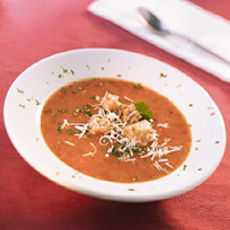TIP OF THE DAY: Garnish With Dried Herbs & Spices
 A sprinkle of parsley adds garnish glamour to this plate of pasta. Photo courtesy Galli Restaurant | New York City. |
We love garnishing dishes with fresh herbs: We snip them onto everything from breakfast eggs to soup, salad and sandwiches to main courses and sides. But what if you don’t have any on hand? Reach for the dried herbs and spices. If you frequent finer restaurants, you may notice that the chef sometimes sprinkles dried herbs or spices as a garnish around the rim of the plate or bowl. Why? It ads artistry and color as well as flavor; you can dip forkfuls of food into the garnish. You can use fresh or dried herbs or spices, chopped nuts or seeds. How many of the following do you already have in your pantry? |
|
|
TAKE YOUR PICK |
 Tomato soup with a very light rim garnish, and more garnish glamour in the center. Photo courtesy Wisconsin Milk Marketing Board. |
|
|
A side benefit of garnishing with herbs and spices: You use them up more quickly, so the flavor doesn’t fade on the shelf. FOOD 101: GARNISH To garnish means to provide something ornamental; to adorn or decorate.* With food, it means something that adds flavor or decorative color. One of the classic food garnishes in America: boiled potatoes garnished with chopped parsley. MORE WAYS TO GARNISH EVERYTHING See our article, Garnish Glamour, for many ways to garnish both savory and sweet foods. *In the law, garnish means to attach money due or property belonging to a debtor.
|
||


